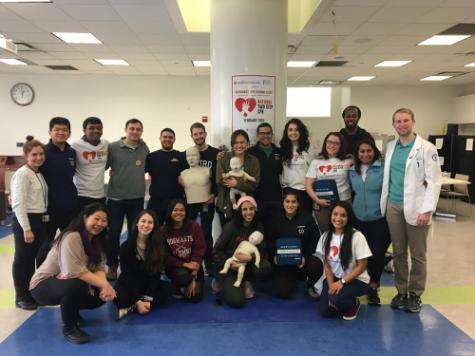Hands-On Compression to Save Lives
Touro College of Osteopathic Medicine Students Teach “National Two Step CPR"

New York, N.Y. – The 4th floor cafeteria of Touro College of Osteopathic Medicine’s Harlem campus was filled Sunday with the sounds of plastic manikins being tapped on the shoulders and chants of “Are you OK?” Close to 70 TouroCOM students and children with their parents practiced saving a loved one or stranger who might be in cardiac arrest - their heart had stopped.
The occasion was part of the 5th annual “National Two Step CPR: Save a Life Campaign”. Free hands-only CPR (cardiopulmonary resuscitation) training was offered by medical student volunteers around the country to educate the public on how to do compressions-only/hands-only CPR and its benefits.
“Anyone can learn the technique and they should not be afraid to try,” said Evelyn Rajan, a second-year TouroCOM student who planned the school’s participation. “Doing something is better than doing nothing. Just by doing compression you’re helping if the heart stops. Those are precious minutes. The more people who learn, the more lives that can be potentially saved.”
Lead Cause of Death
Sudden cardiac arrest is a leading cause of death in the United States. The heart cannot pump blood to the rest of the body, including the brain and lungs. Death can happen in minutes without treatment. The chest compressions mimic how the heart pumps, which helps keep blood flowing.
The TouroCOM students demonstrated how to improve the odds of survival if someone is unresponsive and not breathing. If they don’t get a response to their shoulder taps and query, it’s crucial to take these two steps:
- Call 911 (or have someone else call 911)
- Press hard on the center of the chest with the palms of the hands until help arrives
Nervous About CPR
Attendees expressed some relief after trying the exercises. “I was always nervous about breaking bones or ribs while doing CPR but I know now it’s OK as long as I get the heart stimulated until the EMS comes,” said Sheila Avila, who participated with her nine-year-old daughter, Selae.
Added Okeefa Plaskett, who brought her 15-year-old daughter, Shamya, “It’s something I didn’t know and my daughter didn’t know. It’s really great and very important to learn because you never know, in an emergency she can help save someone’s life.”
“I always thought CPR was easy. It is, but there’s more to it. Now I know what to do and if I have a son or daughter I’ll know what to do, just in case,” observed Brenn Quiones.
The same methods used in the National Two Step are recommended by other groups as well, including the Centers for Disease Control and the American Heart Association. According to the event’s sponsors, in the past CPR involved rescue breaths but the latest and most accurate research shows that chest compressions and early defibrillation (use of a device that can shock and restart the heart) are the most important parts of CPR.
National Two Step was launched in 2016 with the support of Dr. Mehmet Oz’ HealthCorps. The project has trained over 18,500 in correct compressions-only CPR technique with the help of 700 medical students each year. This year TouroCOM was the only medical school in New York to participate.
About the Touro College and University System
Touro is a system of non-profit institutions of higher and professional education. Touro College was chartered in 1970 primarily to enrich the Jewish heritage, and to serve the larger American and global community. Approximately 19,200 students are currently enrolled in its various schools and divisions. Touro College has 30 campuses and locations in New York, California, Nevada, Berlin, Jerusalem and Moscow. New York Medical College; Touro University California and Touro University Nevada; Touro University Worldwide and its Touro College Los Angeles division; as well as Hebrew Theological College in Skokie, Ill. are separately accredited institutions within the Touro College and University System. For further information on Touro College, please go to: www.touro.edu/news

